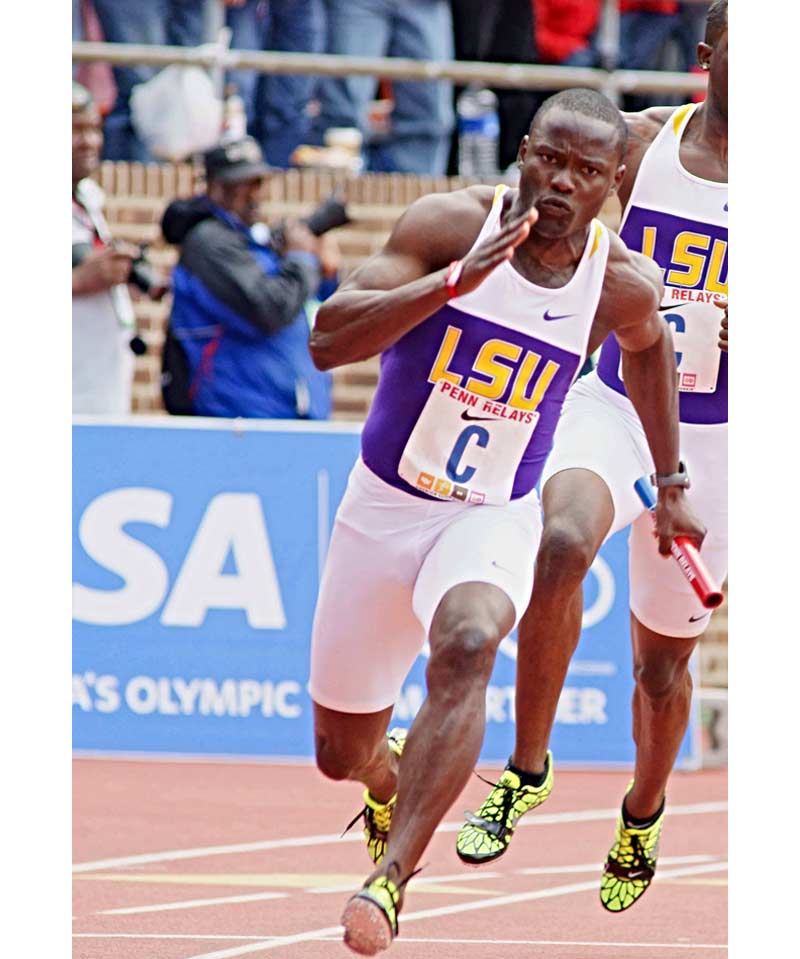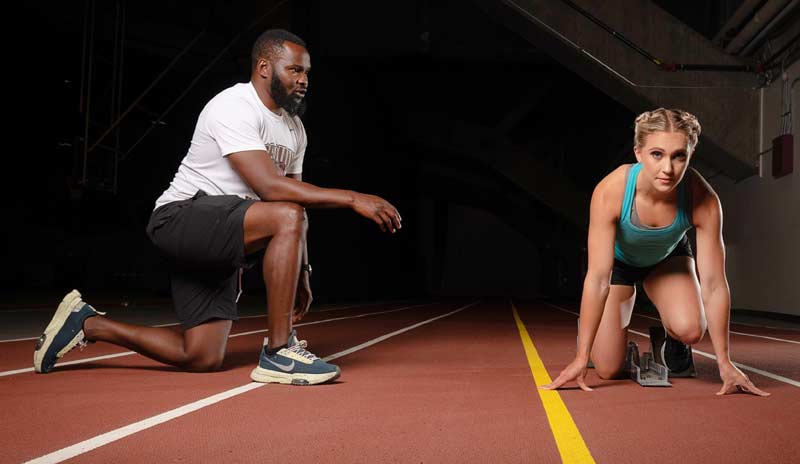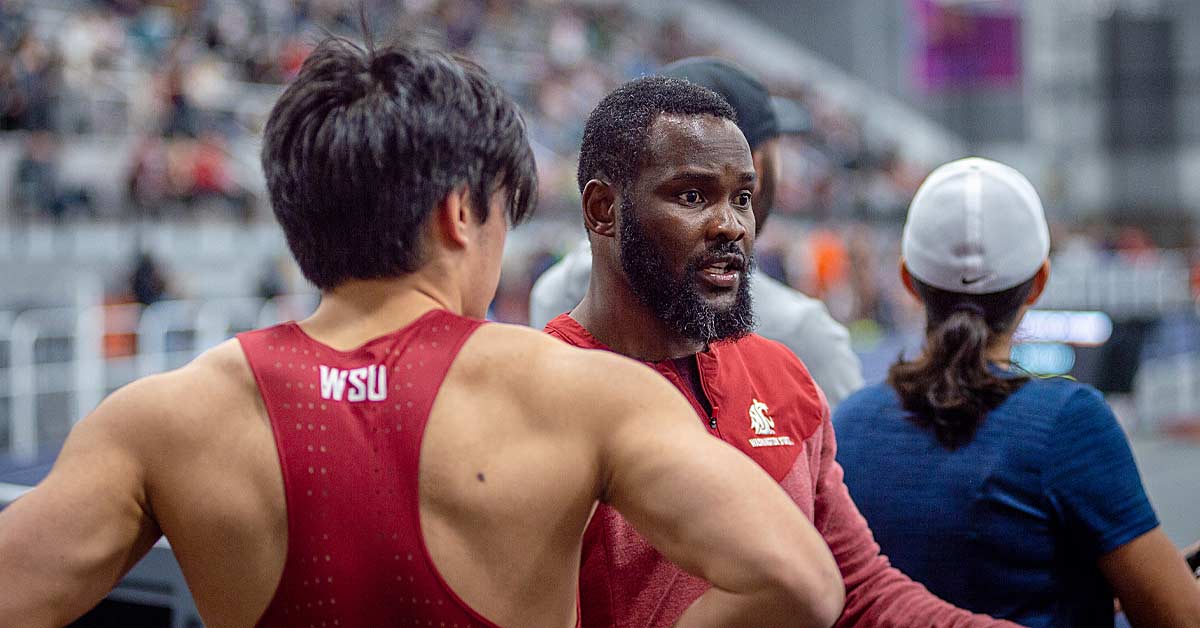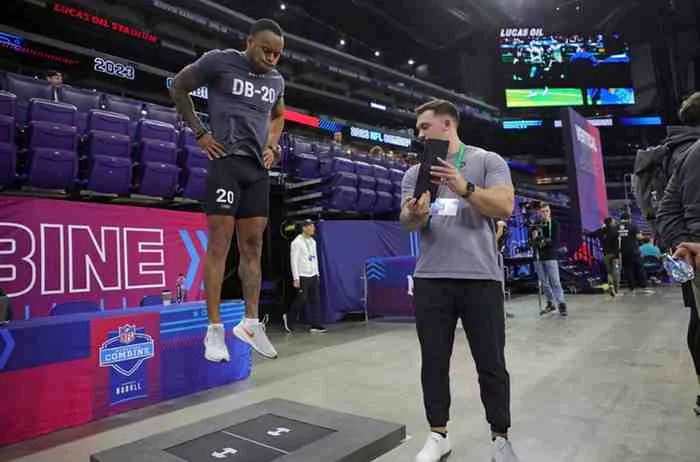Gabriel Mvumvure has experienced “the road less traveled” as a sprint and hurdle coach, coaching in the SEC, the Ivy League, and the PAC-10 conference. As an athlete, Mvumvure competed in five IAAF World Championships and the 2016 Olympics, representing Zimbabwe in the 100 meters. He is the Zimbabwe National Indoor Record Holder in the 60m with 6.6, and at the time, his 9.98 best ranked him as the seventh-fastest 100m in African history.
In 2008, Mvumvure earned an NCAA title on the 4x100m relay team for Louisiana State University, the SEC college where he began his coaching career as a volunteer assistant. He graduated from LSU in 2011 with a B.A. in International Relations and Political Science and raced professionally from 2012 to 2016. In 2019, he took the head coaching position for sprints and hurdles at Brown University, where his accomplishments included two school records (held for 63 and 32 years!), 33 Top 10 performances, and 109 personal bests. In 2022, he began coaching at Washington State University. In his first year, his sprinters and hurdlers collectively broke 108 personal bests (60 men, 48 women).
(Lead photo courtesy of Chris Paige, Washington State Athletics)
Freelap USA: What are the primary differences in athletic talent you’ve seen in the conferences you coached?
Gabriel Mvumvure: First, you need to understand that NCAA Division I is so competitive that no matter how fast you are as a high school athlete, you will face tough competition in college. I was in Austin this year for the Nationals. One of my 100-meter guys ran well but couldn’t make the finals because there were seven sub-10 finishers in that event!
If I’m to be frank, the most talent you’ll see in D1 in the sprints and hurdles is in the SEC—their meets are heavily contested, like mini-nationals. However, the West Coast colleges can make up some ground in team scoring because they excel in the distance events.
It’s a totally different experience in the Ivy League because everything is based on tradition rather than performance. For example, they score six positions instead of eight. That might be a little backward, and it affects the talent you can attract because you’re limited in your accomplishments as a team. In the PAC 12, it’s hard to finish in the Top 3, so being able to score points with those two additional placements is important.
On the plus side, an athlete who was passed up by major Division I colleges because of poor times or their injury history may find opportunities at an Ivy League college. My hurdler Bretram Rogers suffered a severe hamstring injury during his senior year in high school that ripped muscle from bone and severed nerves. In his senior year at Brown, he broke the indoor 60m hurdle record that stood for 63 years and the 100m outdoor record that stood for 15 years. Maddie Frey was a high school soccer player who tore her ACL. After a lengthy recovery, Maddie switched to track—she even ran cross country. During her senior year at Brown, Maddie broke the 200m outdoor record that stood for 32 years. Both athletes are headed to medical school.

Freelap USA: What have been your challenges in recruiting for each conference?
Gabriel Mvumvure: The Ivy League doesn’t offer scholarships, and their acceptance rate is only around 8%. In my experience, it’s more complicated from an administrative standpoint to sign an athlete at Brown than at other Ivy League schools such as Princeton or Harvard. I often lost athletes who committed to Brown but ended up going to another Ivy League school because we were going after the same athletes. Plus, it was tough at Brown to recruit international athletes.
With SEC and PAC 12 schools, the hardest part is that any good athlete will be recruited by other schools in the conference. Your success in getting those athletes is influenced by the recent success of your track and field team and your facilities. On this last point, consider the weather. Do you have a proper facility to train year-round? If you’re in a hot climate like Louisiana, do you have an indoor facility where you can dodge the heat?
A lot of your success in recruiting depends on how tenacious and honest you are. I say “honest” because it’s easy for athletes to transfer, so my approach is that I make it clear to athletes that I am recruiting them for four years.
Freelap USA: Would you explain what you mean when you say that high school athletes often make the mistake of trying to “run too fast?”
Gabriel Mvumvure: The term “too fast” is subjective because it’s obviously a good problem to have. But what creates sustainability in making progress in sprinting and hurdling is having good mechanics because no matter how strong you are, you’re going to get stronger.
Let me explain. I have a 15-month-old daughter. If I ask her to punch a wall, she’ll punch it, and it will probably sting a little because she doesn’t have enough power to punch through it. If I were to ask an 8-year-old to punch a wall as hard as they can, they might have cuts on their skin and bruises on their knuckles. But if I were to ask a 25-year-old to punch a wall as hard as they can, they’d break some bones. If a sprinter’s mechanics are not on point, they’ll struggle to stay healthy because it’s like that 25-year-old punching the wall.
One of the biggest mistakes I’ve seen with the high school athletes I’ve recruited is them thinking that the longer their stride, the faster they’ll run... That’s not sprinting, says @GabrielMvumvure. Share on XWhen I recruit athletes, I certainly watch their home videos, but I like to go to track meets as often as possible to see them complete. I also need to know as much about their training as possible, such as how much volume they have done. This background lets me know what I have to change or adjust to make them better. So, it’s more than just getting my athletes to run faster, but to run faster with fewer injuries.
One of the biggest mistakes I’ve seen with the high school athletes I’ve recruited is them thinking that the longer their stride, the faster they’ll run because they’ll cover more ground. That’s not sprinting. Sprinting is all about how much force you apply into the ground and how fast you are doing it to get to the finish line. I tell my athletes to focus on striking down hard at center mass to create a short ground contact time and apply more force into the ground to propel them forward.

Freelap USA: What is your experience with velocity-based training?
Gabriel Mvumvure: My experience has been very positive. With the events I coach, the sprints and the hurdles, the lifting has to have a purpose in terms of being able to move fast. What I like about velocity-based training is that science shows you all the things in nature, and as a coach, you have to kind of “copy” those things with your training. Consider the differences between the lion and the cheetah.
A lion is way stronger than a cheetah but heavier—that’s why the cheetah is faster. With velocity-based training, you get the strength and power of a lion but maintain the size of a cheetah. It’s also good for the athlete because of the feedback it gives you. At Washington State, we have a monitor on each lifting platform that shows the athlete the bar speed for each rep. When our athletes lift a weight, if they see two red bars on the monitor, they are moving too slowly and need to reduce the weight on their next set.
Why is this important?
A lion is way stronger than a cheetah but heavier—that’s why the cheetah is faster. With velocity-based training, you get the strength and power of a lion but maintain the size of a cheetah. Share on XIf an athlete cannot lift a weight at the speed we want, they will be training muscle fibers that will not contribute to performance and may increase body mass, which can hurt performance. At Brown, with our training, many of our athletes lost body weight while increasing their power, resulting in better times.
Freelap USA: What is your best advice for a high school athlete seeking a scholarship?
Gabriel Mvumvure: Recruiting services can help get an athlete noticed. One benefit I found working with these agencies is that they have been good at giving me all the information I need about an athlete early, such as their progress and achievements. They also respond quickly to my questions. Recruiting services are a plus, but the nice thing about track and field is that everything is based on your personal bests, and it doesn’t matter how you did it.
I’ve recruited athletes who didn’t use those recruiting services but instead sent me detailed emails telling me about themselves. These athletes must work hard to make a good impression. What can make a difference is telling the coach their goals, why they want to attend the school, and what they like about the track and field program. Every coach wants to recruit athletes who are passionate about being on their team!
Since you’re here…
…we have a small favor to ask. More people are reading SimpliFaster than ever, and each week we bring you compelling content from coaches, sport scientists, and physiotherapists who are devoted to building better athletes. Please take a moment to share the articles on social media, engage the authors with questions and comments below, and link to articles when appropriate if you have a blog or participate on forums of related topics. — SF





